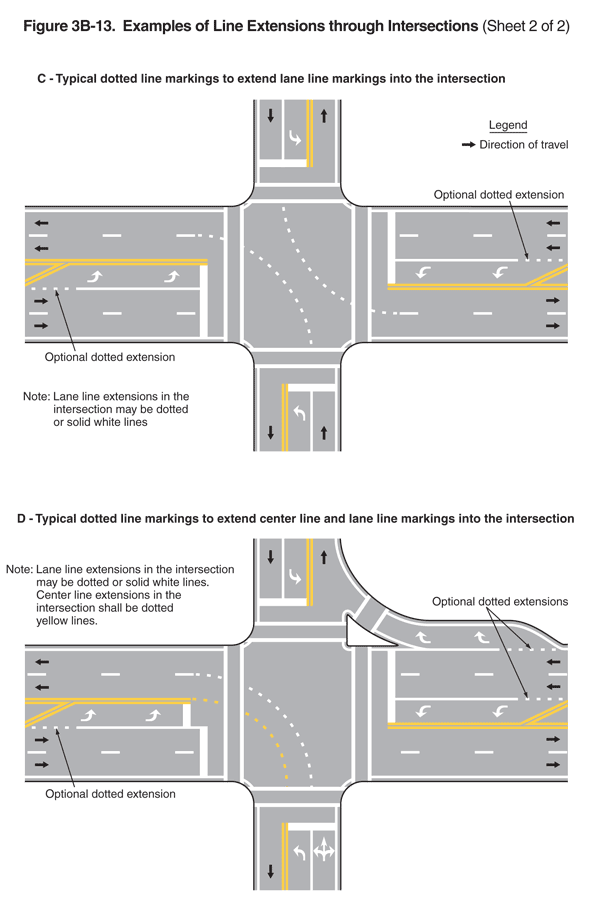2009 Edition Part 3 Figure 3B-13. Examples of Line Extensions through Intersections (Sheet 2 of 2)

Figure 3B-13. Examples of Line Extensions through Intersections (Sheet 2 of 2)
This figure illustrates four examples of line extensions through intersections or interchanges: A, B, C, and D. The figure is composed of two sheets.
Sheet 2 of the figure shows two highway intersections, examples C and D. A legend shows a black arrow indicating the direction of travel in the lanes:
- The third example is labeled "C - Typical dotted line markings to extend lane line markings into the intersection." A note states "Lane line extensions in the intersection may be dotted or solid white lines":
- This figure shows the intersection of a five-lane horizontal roadway with a three-lane vertical roadway. Arrows show that the direction of travel is two lanes eastbound and two lanes westbound with opposing center turn lanes on the horizontal roadway, and one lane northbound and one lane southbound with opposing center turn lanes on the vertical roadway.
- The horizontal roadway is composed of two through lanes in each direction and a center left turn lane. The vertical roadway is composed of one through lane in each direction and a center turn lane. On both roadways, the through lanes are divided from each other by a broken white line. The left turn lane is divided from the same direction through lanes by a solid white line, with an optional dotted white line extension in advance of the solid white line. The beginning of the left turn lane is shown by a solid double yellow line that angles from the broken white line to the solid double yellow line that separates the turn lane from the oncoming lanes. White turn arrows are marked in the turn lanes. A solid white stop line is marked across all approach lanes at the intersection.
- Beginning at the crosswalk on the north side of the vertical highway, a dotted white line extends from the solid white line separating the right lane from the left-turn lane through the intersection, curving 90 degrees to the east, and is omitted inside the east side crosswalk to join the lane line that separates the two eastbound lanes of the eastbound roadway on the east side of the intersection. Beginning at the crosswalk on the south side of the vertical highway, another dotted white line extends from the solid white line separating the right lane from the left-turn lane through the intersection, curving 90 degrees to the west, and is omitted inside the west side crosswalk to join the lane line that separates the two westbound lanes on the westbound roadway on the west side of the intersection.
- On each side of the intersection on each roadway are two parallel solid white lines denoting crosswalks.
- The fourth example is labeled "D - Typical dotted line markings to extend center line and lane markings into the intersection." A note states "Lane line extensions in the intersection may be dotted or solid white lines. Center line extensions in the intersection shall be dotted yellow lines.":
- This figure shows an intersection similar to that shown as example C, with a five-lane horizontal roadway intersecting a three-lane vertical roadway. Arrows show that the direction of travel is two lanes eastbound and two lanes westbound with opposing center turn lanes on the horizontal roadway, and one lane northbound and one lane southbound with opposing center turn lanes on the vertical roadway. On both roadways, the through lanes in the same direction are divided from each other by a broken white line. The left turn lane is divided from the same direction through lanes by a solid white line, with an optional dotted white line extension in advance of the solid white line. The beginning of the left turn lane is shown by a solid double yellow line that angles from the broken white line to the solid double yellow line that separates the turn lane from the oncoming lanes. White turn arrows are marked in the turn lanes. A solid white stop line is marked across all approach lanes at the intersection.
- On the east side of the intersection, a separate westbound right-turn lane is shown as the rightmost lane. It is separated from the right through lane by a solid white line that forms a gore at the intersection as the turn lane begins to curve to the north. At the point where the right-turn lane curves past the northeast corner of the intersection, two parallel solid white lines denoting a crosswalk are shown across the turn lane. A white triangular island is shown to the left of the crosswalk with the point of the island extending to the far edge of the vertical and horizontal crosswalks in the intersection. The right-turn lane continues curving and merges with the northbound lane of the vertical roadway on the north side of the intersection.
- Beginning at the crosswalk on the south side of the vertical highway, a single dotted yellow line extends from the solid double yellow line separating the left-turn lane from the opposing through lane through the intersection, curving 90 degrees to the west and is omitted inside the west side crosswalk, to join the solid double yellow line that separates the left-turn lane from the two westbound lanes on the west side of the intersection. Also beginning at the crosswalk, a single dotted white line extends from the solid white line separating the two left-turn lanes through the intersection, curving 90 degrees to the west and is omitted inside the west side crosswalk, to join the broken white line that separates the two westbound through lanes on the west side of the intersection.
- On each side of the intersection on each roadway are two parallel solid white lines denoting crosswalks.
Back to: Sheet 1
